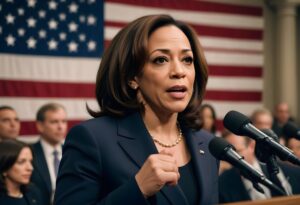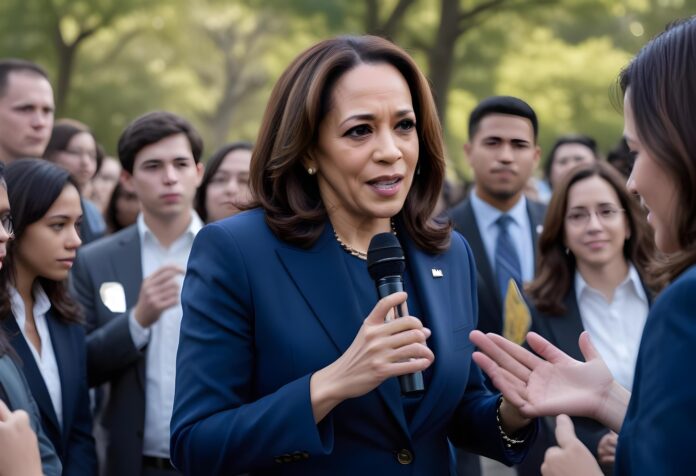In the fast-paced world of political news, few topics ignite as much passion as media bias and the portrayal of public figures. Recently, a guest on Fox Business stirred the pot by accusing the media of trying to “sell” Kamala Harris as “Obama in a skirt.” This comment raises significant questions about how the media covers political figures and whether biases influence these portrayals.
Kamala Harris
Kamala Harris, the first female Vice President of the United States and a trailblazer in her own right, embodies a complex and multifaceted identity. With roots tracing back to both Indian and Jamaican heritage, she represents a blend of cultures that enriches her political narrative. Known for her sharp wit and formidable presence, Harris has consistently tackled contentious issues like criminal justice reform and healthcare, often drawing on her experiences as a former prosecutor. As the spotlight remains firmly on her, the conversation around her identity and the implications in media portrayal continues to evolve, prompting both supporters and critics to reflect on what it means to lead in today’s political landscape.

In this blog post, we’ll explore the media’s portrayal of Kamala Harris, investigate claims of bias, and examine the impact of identity politics. We will provide direct quotes, comparative analyses, data on media mentions, and examples from various news outlets to paint a comprehensive picture. Whether you’re a media critic, political analyst, or news enthusiast, this post aims to offer valuable insights into this heated debate.
The Media’s Influence on Political Narratives
The media holds immense power in shaping public opinion. How news outlets present a political figure can significantly impact their public image. Kamala Harris, as the first female Vice President of colour, has been a focal point for media coverage. But is this coverage fair and unbiased?
Accusations of Media Bias
Recently, a guest on Fox Business accused the media of trying to “sell” Kamala Harris as “Obama in a skirt.” This statement suggests that the media is overemphasizing Harris’ identity rather than her policies or qualifications. It’s crucial to examine these claims to understand the broader implications.

Direct Quotes and Perspectives
During the Fox Business segment, the guest stated, “The liberal mainstream media is giving Kamala Harris the Hillary Clinton and Barack Obama treatment.” This comment implies a deliberate effort to favourably portray Harris because of her identity. Such statements highlight concerns about media bias that many critics share.
Comparative Analysis of Media Coverage
Analysing the media coverage of Kamala Harris compared to other political figures can reveal potential biases. For instance, comparing the tone and frequency of mentions of Harris with those of Mike Pence during their respective vice-presidencies can provide valuable insights.
Data on Media Mentions
Data analytics tools can track the frequency and sentiment of Kamala Harris mentions across various news platforms. By assessing this data, we can identify patterns and biases in how different media outlets portray her. For example, a higher volume of positive mentions in liberal-leaning outlets versus conservative ones could support the bias claims.
Identity Politics in Media Coverage
Identity politics often play a significant role in media portrayals. Kamala Harris’ unique background as a Black and Indian American woman adds layers to her coverage. But does this focus on identity overshadow her policies and achievements?
The Role of Identity in Political Favouritism
Some critics argue that the media’s emphasis on Harris’ identity is a form of favouritism. Monica Crowley, a former Trump spokesperson, asserted that liberals support Harris more for her background than her policies or credentials. This perspective suggests that identity politics may skew media coverage.
The Hillary Clinton and Barack Obama Treatment
Crowley’s comparison to Hillary Clinton and Barack Obama implies a pattern in media behaviour. Clinton and Obama received extensive media coverage that often highlighted their ground-breaking roles. Is Harris receiving similar treatment, and if so, is it justified or biased?
Public Perception and Media Influence
The media’s portrayal of Kamala Harris can shape public perception. When the media focuses on identity, it can create momentum based on representation rather than substance. This influence is powerful, but it also raises questions about journalistic integrity and objectivity.
Examining Headlines and Articles
To understand the media’s role in shaping Harris’ image, we must examine specific headlines and articles. By comparing how different outlets cover the same events, we can identify potential biases and draw conclusions about their impact.
Supportive Coverage Examples
Liberal-leaning outlets often highlight Harris’ achievements and milestones. For instance, a headline like “Kamala Harris Breaks Barriers as First Female VP of Colour” emphasizes her identity and ground-breaking role. This type of coverage can inspire and resonate with specific audiences.
Critical Coverage Examples
Conversely, conservative-leaning outlets may focus on perceived shortcomings. A headline like “Kamala Harris Faces Criticism Over Border Crisis Management” shifts the narrative to her policy performance. This approach appeals to a different audience and emphasizes accountability.

Balanced Coverage Examples
Some outlets strive for balanced reporting. For example, a headline like “Kamala Harris’ Historic Role and Policy Challenges” provides a comprehensive view, acknowledging her identity while addressing policy issues. Balanced coverage is essential for informed public discourse.
The Complexity of Media Bias
Media bias is a multifaceted issue. It involves not only the content of coverage but also the tone, framing, and frequency of mentions. Understanding these nuances is crucial for evaluating the media’s portrayal of Kamala Harris.
Tone and Framing
The tone of media coverage can significantly influence public perception. Positive framing can enhance a political figure’s image, while negative framing can damage it. Analyzing the tone and framing of Harris’ coverage reveals potential biases and their impact.
Frequency of Mentions
The frequency of mentions also matters. A high volume of coverage can create a sense of importance and relevance. Tracking the frequency of Kamala Harris mentions across different outlets helps identify patterns and highlight potential biases.
Impact on Public Opinion
Ultimately, media bias shapes public opinion. The way Kamala Harris is portrayed can influence how people perceive her and her capabilities. Understanding this impact is essential for a fair and informed political discourse.
Conclusion
The media’s portrayal of Kamala Harris is a complex and contentious issue. Accusations of bias and identity politics raise important questions about journalistic integrity and fairness. By examining direct quotes, comparative analyses, data on media mentions, and specific headlines, we can gain a deeper understanding of this debate.
For media critics, political analysts, and news enthusiasts, this topic is more than a passing headline. It’s a reflection of broader societal dynamics and the power of the media in shaping political narratives. Whether you’re a supporter or a critic, understanding the nuances of media coverage is crucial for an informed and balanced perspective.
Stay engaged with the conversation and continue to explore the impact of media on politics. Your insights and perspectives contribute to a richer and more nuanced understanding of our world.
Feel free to share your thoughts and join the discussion. Together, we can strive for a more informed and balanced media landscape.
Additional Resources for Further Exploration
If you’re keen on diving deeper into the complexities of media coverage and its impact on political figures like Kamala Harris, check out these engaging external resources:
- Pew Research Center: The Role of Media in Politics – This site provides insights and data on how media influences political discourse and public opinion.
- NPR’s Media Bias Fact Check – A handy resource for spotting bias in various media outlets and understanding reporting styles.
- Columbia Journalism Review – This magazine offers in-depth analyses and critiques of current journalism practices and trends, focusing on fairness and integrity.
- FactCheck.org – A non-profit website that aims to reduce the level of deception in U.S. politics by providing well-researched fact-checks of public statements and media coverage.
Feel free to explore these links to enhance your understanding and broaden the conversation around media portrayal in politics!
Stay Updated with Current Affairs
For those who love to stay in the loop about the latest happenings and political discussions, check out FitBizHouse’s Current Affairs section. This resource offers a lively mix of articles and insights that dive into the pressing issues of the day, including media coverage and political narratives. It’s a great spot to sharpen your understanding and engage with a vibrant community interested in the latest developments. So dive in and get inspired by the conversations around current events!


